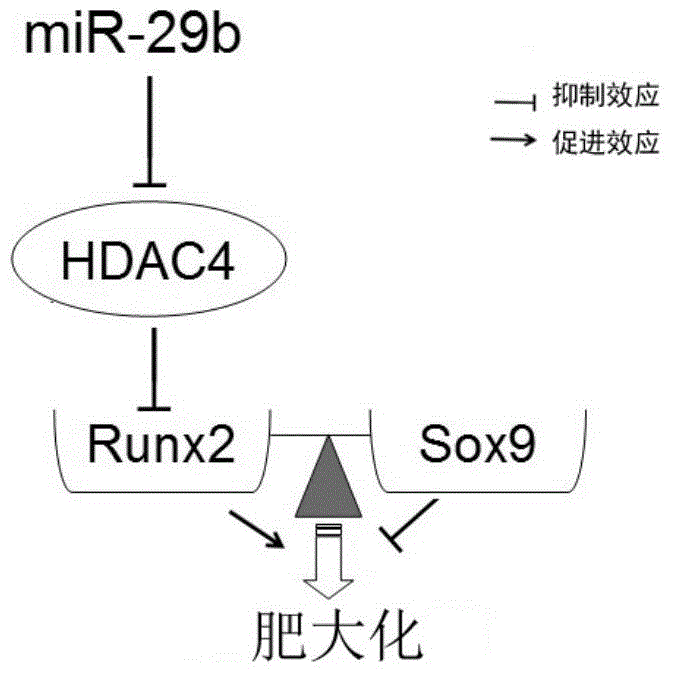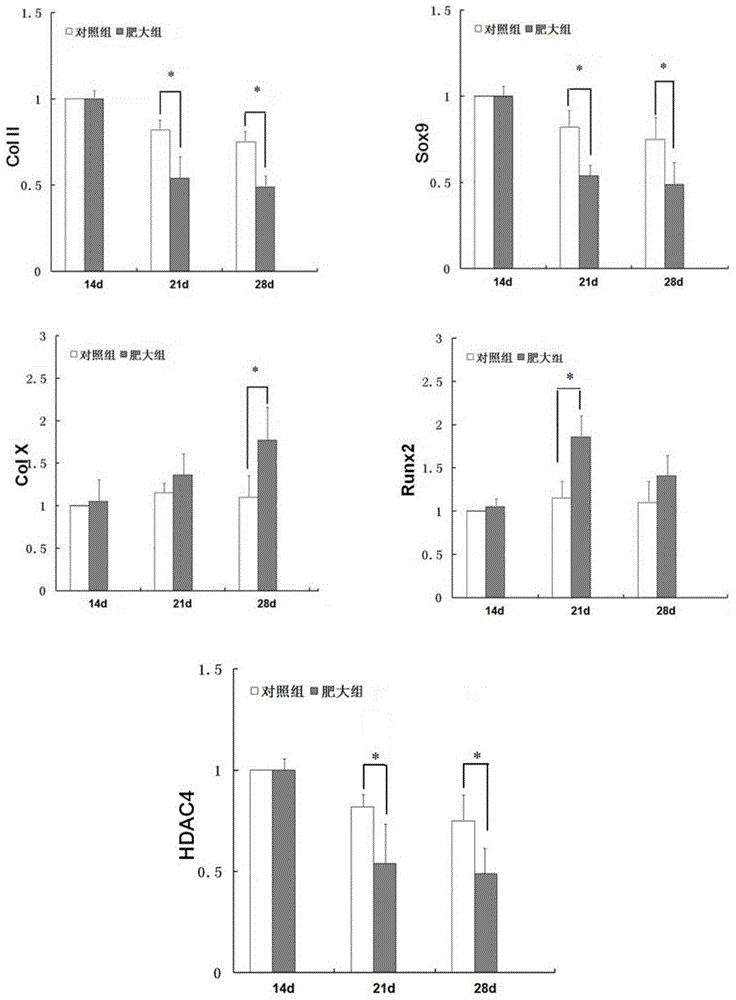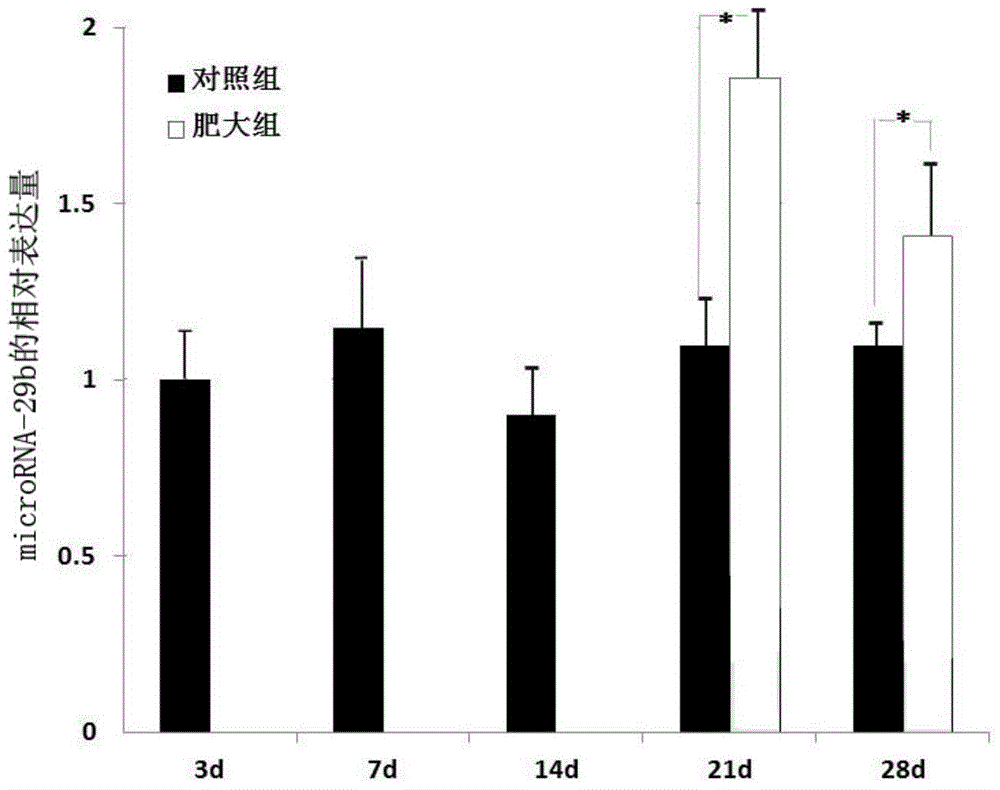Application of microRNA-29b in articular cartilage repair as drug target
A cartilage repair and drug technology, applied in the field of cartilage tissue engineering, to prevent cartilage fibrosis and heterotopic ossification, realize tissue engineered cartilage repair, and promote maintenance and stability
- Summary
- Abstract
- Description
- Claims
- Application Information
AI Technical Summary
Problems solved by technology
Method used
Image
Examples
Embodiment 1
[0035] Example 1 Mesenchymal stem cell cell culture and hypertrophic chondrogenic differentiation induction experiment
[0036] (1) Acquisition and culture of mouse bone marrow mesenchymal stem cells
[0037] Under sterile conditions, use a 1 mL syringe to flush the bone marrow of the mouse femur, transfer it into a centrifuge tube containing 5 mL of DMEM medium, and gently pipette to make a cell suspension; transfer the cell suspension to a cell suspension containing 5 mL of lymphocytes. In the centrifuge tube of the separation liquid, centrifuge at 2000r / min for 20min; after centrifugation, collect the mononuclear cells of the cloudy buffy coat and place them in another centrifuge tube, wash twice with DMEM low-sugar medium, and centrifuge (1000r / min). min, 5min), discard the supernatant, resuspend the cells in DMEM basal medium containing 15% fetal bovine serum, and finally use the primary cells at 1×10 6 Cells / mL were seeded in culture flasks and placed at 37°C, 5% CO 2 ...
Embodiment 2
[0040] Example 2 The increased expression of microRNA-29b promotes the process of chondrocyte hypertrophy
[0041] (1) The cell clusters of 14d, 21d and 28d differentiated by cartilage induction were taken, total RNA was extracted and reverse transcribed into cDNA. The specific operation of reverse transcription is as follows: put the PCR tube on ice, and add 5 μL 5×RT Reaction Buffer, 1 μL 25mM dNTP mixture, 1 μL 25U / μL RNase inhibitor, and 1 μL 200U / μL M-MLV reverse transcription respectively. Enzyme and 4 μL of DEPC water, then the mixture of RNA and primers was added to make the total reaction volume 25 μL. After mixing the above components, water bath at 42 °C for 60 min, and finally heated to 85 °C for fire treatment for 5 min to obtain a cDNA solution. Store at -70°C for later use.
[0042] The mRNA sequences of type II collagen (Col II), type X collagen (Col X), Sox9 and internal reference gene GAPDH were obtained from the Nucleotide database, and the corresponding PC...
Embodiment 3
[0065] Example 3 Transfection of microRNA-29b inhibitor can significantly inhibit the expression of hypertrophic chondrocyte-related genes
[0066] Transfection experiment: using Lipofectamin TM 2000 kit, take the normal cultured mesenchymal stem cells for cell-forming micromass culture, use medium B (complete cartilage induction medium containing TGF-β3) for cartilage induction culture for the first 14 days, and change to medium from the 15th day C (hypertrophic cartilage induction complete medium) continued to be cultured, and materials were collected on the 14th, 21st, and 28th days of culture for subsequent experimental detection. The experiment was divided into two groups: the control group and the experimental group. The experimental group was transfected with microRNA-29b inhibitor, and the control group was transfected with microRNA-29b inhibitor negative control (bioinformatics analysis showed that it was related to the genomes of humans, mice, and rats, and All miR...
PUM
 Login to View More
Login to View More Abstract
Description
Claims
Application Information
 Login to View More
Login to View More - R&D
- Intellectual Property
- Life Sciences
- Materials
- Tech Scout
- Unparalleled Data Quality
- Higher Quality Content
- 60% Fewer Hallucinations
Browse by: Latest US Patents, China's latest patents, Technical Efficacy Thesaurus, Application Domain, Technology Topic, Popular Technical Reports.
© 2025 PatSnap. All rights reserved.Legal|Privacy policy|Modern Slavery Act Transparency Statement|Sitemap|About US| Contact US: help@patsnap.com



